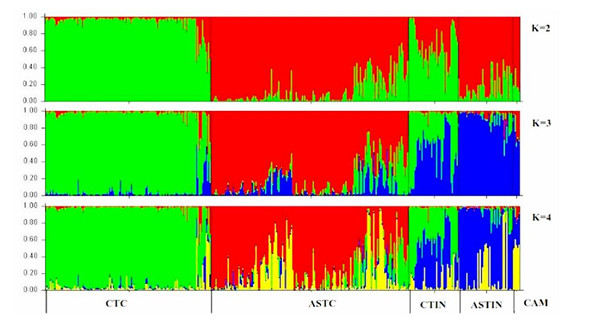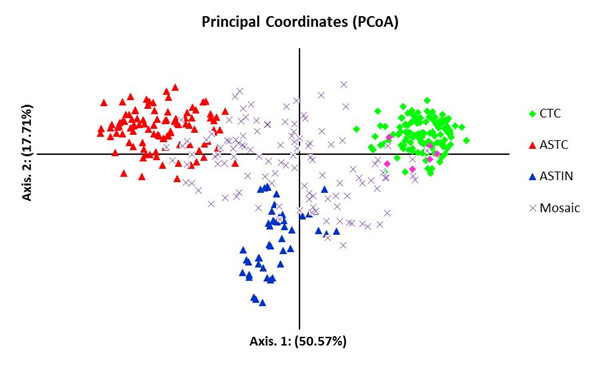PLoS ONE:中科院昆明植物所高连明和李德铢研究组发表茶树栽培驯
2016年5月24日,国际知名学术期刊《PLoS ONE》在线发表了中国科学院昆明植物研究所高连明研究组和李德铢研究组合作的题为“Indications for Three Independent Domestication Events for the Tea Plant (Camellia sinensis(L.) O. Kuntze) and New Insights into the Origin of Tea Germplasm in China and India Revealed by Nuclear Microsatellites”的研究结果,研究论文报道了茶树栽培驯化起源研究成果。
茶树((Camellia sinensis (L.) O. Kuntze))是我国最早驯化的木本作物之一,栽培历史悠久,并通过古丝绸之路和茶马古道直接或间接地传播到世界各地。目前全球共有52个国家种植茶叶,茶已成为世界上最受欢迎的三大无酒精饮料之一。东亚和南亚地区是全球最重要的茶叶种植和生产中心,约占全世界总产量的85%,其中,中国和印度则是两个最大的产茶国,也被认为是栽培茶树的驯化中心。由于至今没有发现茶树的野生居群,有关茶树的栽培起源与驯化历史一直存在较大的争议(如大叶茶和小叶茶为一次驯化还是多次驯化起源)。
研究人员利用23对核基因组微卫星(SSR)标记对采自中国和印度的392份茶树种质资源(包括古茶树、茶树老品种和现代栽培品种等)开展了栽培驯化起源研究。研究结果表明:茶树可以分为3个遗传分组(茶树类型),即小叶茶(主要分布于中国除云南以外的各省区)、中国大叶茶(主要栽培于云南省及周边国家)和印度大叶茶(主要分布于印度阿萨姆地区),表现出明显的地理分布格局;在研究的茶树样品中,包括了大量三种茶树类型间的杂交品种,表明杂交很可能是茶树品种选育的重要方式;小叶茶,中国大叶茶和印度大叶茶很可能是在中国和印度不同地区独立驯化起源的,我们推测中国东部和南部地区很有可以是小叶茶的栽培驯化中心,而云南西部或南部与印度阿萨姆地区分别是中国大叶茶和印度大叶茶可能的栽培驯化中心;首次发现中国云南栽培的大叶茶代表新的遗传谱系,而与印度大叶茶不同,是重要的茶树种质资源,为今后茶树种质资源的保护和新品种的选育具有重要科学意义。

图1. 基于23对核基因组微卫星标记的STRUCTURE遗传分组分析(K = 2, 3 , 4)

图2. 392份茶树样品基于23对核基因组微卫星标记的主成分分析
原文链接:
Indications for Three Independent Domestication Events for the Tea plant (Camellia sinensis (L.) O. Kuntze) and New Insights into the Origin of Tea Germplasm in China and India Revealed by Nuclear Microsatellites
原文摘要:
Background
Tea is the world’s most popular non-alcoholic beverage. China and India are known to be the largest tea producing countries and recognized as the centers for the domestication of the tea plant (Camellia sinensis (L.) O. Kuntze). However, molecular studies on the origin, domestication and relationships of the main teas, China type, Assam type and Cambod type are lacking.
Methodology/Principal Findings
Twenty-three nuclear microsatellite markers were used to investigate the genetic diversity, relatedness, and domestication history of cultivated tea in both China and India. Based on a total of 392 samples, high levels of genetic diversity were observed for all tea types in both countries. The cultivars clustered into three distinct genetic groups (i.e. China tea, Chinese Assam tea and Indian Assam tea) based on STRUCTURE, PCoA and UPGMA analyses with significant pairwise genetic differentiation, corresponding well with their geographical distribution. A high proportion (30%) of the studied tea samples were shown to possess genetic admixtures of different tea types suggesting a hybrid origin for these samples, including the Cambod type.
Conclusions
We demonstrate that Chinese Assam tea is a distinct genetic lineage from Indian Assam tea, and that China tea sampled from India was likely introduced from China directly. Our results further indicate that China type tea, Chinese Assam type tea and Indian Assam type tea are likely the result of three independent domestication events from three separate regions across China and India. Our findings have important implications for the conservation of genetic stocks, as well as future breeding programs.
doi:10.1371/journal.pone.0155369
作者:高连明和李德铢

